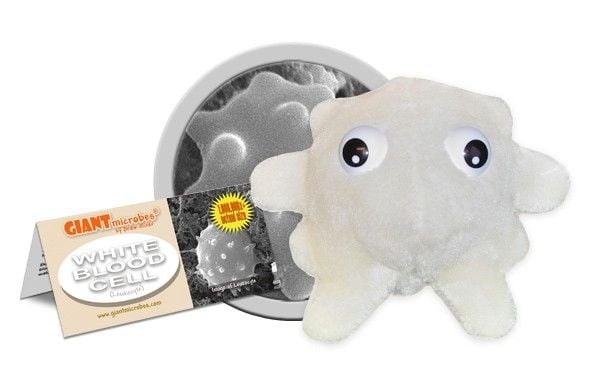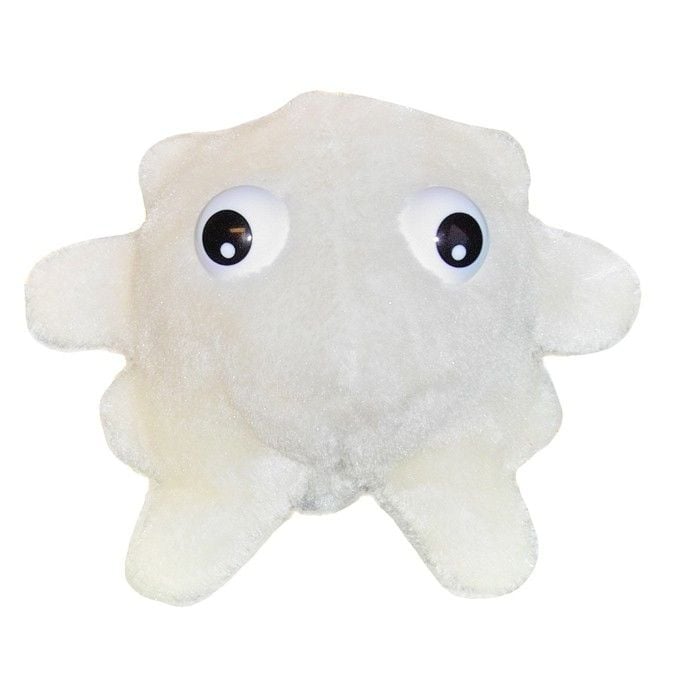White Blood Cell (Leukocyte)
Product Details
Additional Information
| Sizes | Giantmicrobes are based on actual microbes, cells, organisms and other critters, only 1,000,000 times actual size! Gigantic (GG) 40-60cm XL (XL) 25-38cm Original (PD) 12-20cm Minis (MM) 5-10cm each Keychain (KC) 5-10cm with clip |
|---|---|
| Materials | Plush from all new materials. Stuffed with polyester fiber fill. Surface washable: sponge with water & soap, air dry. |
| Packaging | Each plush microbe includes a printed card with fun, educational and fascinating facts about the actual microbe or cell. |
| Safety | Every product meets or exceeds U.S. and European standards for safety. For ages 3 and up. |
All about White Blood Cell (Leukocyte)
FACTS: White blood cells, or Leukocytes ("white cell" in Greek), are your body's white knights. If an enemy germ invades you, they ride to the rescue and fight to the death.
There are several different kinds of leukocytes, and each has special skills that help protect you. For example, neutrophils race to the scene when bacteria attack. They suffer large casualties creating the pus that forms on infections. B cells hurl antibodies at virulent viruses to neutralize them so T cells can move in for the kill. (T cells are also the military historians: they remember old enemies and guard against repeat attacks.) And when the dust finally settles, monocytes help clean up the place by digesting microorganisms and their remains.
Some leukocytes also try to track down any traitorous cancer cells that your body itself produces. This domestic police force attempts to maintain cellular order to keep you healthy. Unfortunately, terrorist cells are hard to spot because they can look almost like normal cells. Chemotherapy and other treatments are usually marshaled to help carry the day (particularly in the case of leukemia, where the leukocytes themselves have gone bad).
But where good health prevails, remember: in every drop of the bloody battlefield, there are a myriad vigilant champions, standing watch night and day to help keep you alive.
| Description | White blood cells are your body’s warriors, fighting against infection and disease. They use the blood stream to get to the places where they need to fight harmful substances like bacteria and viruses. Bone marrow is the factory for white blood cells, which are then stored in the blood and lymphatic tissues. This is a fun gift for medical professionals, students, and teachers! |
|---|
| Name |
Types: Monocytes: break down bacteria and have a long lifespan. The name white blood cell comes from the appearance of the cells after centrifugation. The name leukocyte comes from the Greek: Leuko=white, Cyte=cell. Lymphocytes: make antibodies (hyperlink to antibody page) that help the immune system to protect against harm. Neutrophils: attack bacteria and fungi, and are the most plentiful of all the white blood cells. They are the first line of defense for an infection. Blasophils: release chemicals that inform the immune system of harmful substances. They are involved in allergic reactions. Eosinophils: attack and destroy parasites and cancer cells and help in allergic reactions. |
|---|
| Actual Size | Approx. 12 micrometers, which would be less than an eighth of the thickness of a sheet of paper. |
|---|
| System | Immune system |
|---|
| Quantity | On average: 7,000 per microliter of blood, which translates to over 25 trillion white blood cells in the body. They make up 1% of the blood. |
|---|
| History |
1834: Gabriel Andral and William Addison were both first to view and describe leukocytes. 1865: Max Johann Sigismund Schultze gave the first description of neutrophils and different types of leukocytes. Paul Ehrlich contributed a lot to the research of immune cells. He was the first to identify them, and he showed that the eosinophil leukocytes were mainly produced in bone marrow. |
|---|
| Fascinating Facts |
Osmosis Jones: This 2001 movie with Bill Murray depicts a white blood cell protecting its human from a virus. Blood Wars: Kathy High has produced an art-science installation that puts two different people’s white blood cells together to compete. White Blood Cells: 2001 album by The White Stripes, an alternative rock duo. |
|---|










